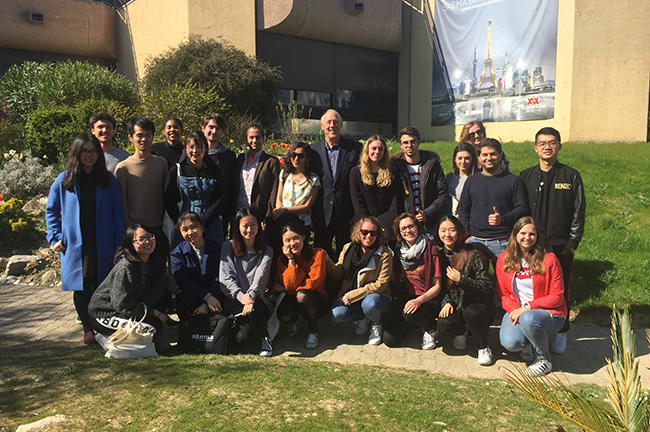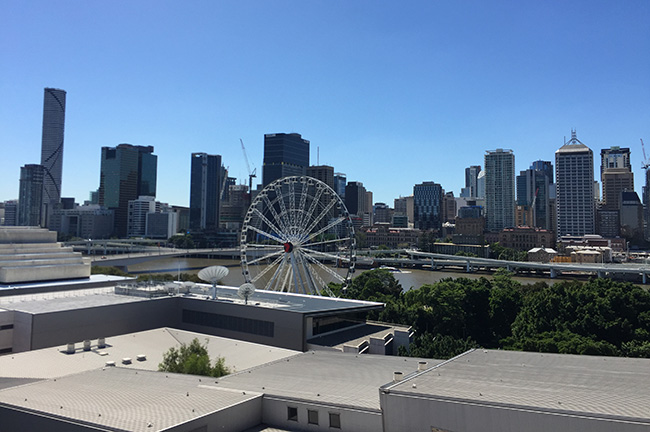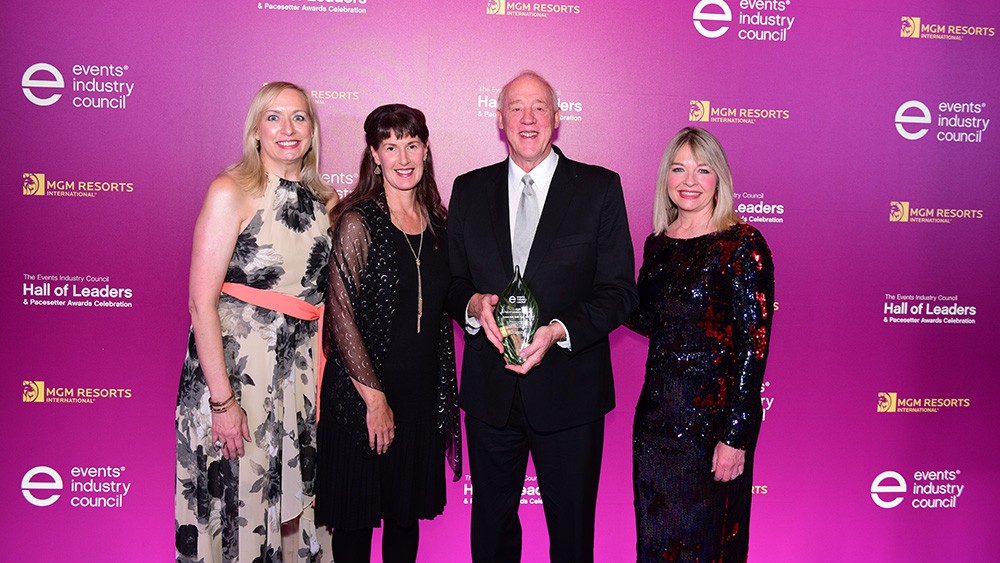The expert of record for all things meetings tech for more than 20 years, Corbin Ball—owner of Corbin Ball & Co.—has ingrained himself in the meetings industry on a global level.
An inveterate traveler—he spends about a third of his time on the road every year, traveling throughout the world to spread the meetings technology gospel as a speaker—Ball recently received the highest honor in the industry after being inducted into the Events Industry Council’s (EIC) Hall of Leaders.
The ceremony took place during IMEX America 2018.
“It’s been the highlight of my career. I feel tremendously honored and happy to be on this list,” Ball said. “I look at the people who I’ve been inducted with and many of them have been my mentors and my friends. It’s kind of like the Academy Awards of the events industry.
“My whole goal when I went out to form my own business was to give back to the industry, and this has been an acknowledgement that I’ve been able to do that,” he added.
How Corbin Ball Got His Start in the Meetings Industry
Like most people involved in the meetings and events industry, Ball didn’t chart out a career path at the beginning to find himself where he is today.
“I was working as the director of educational media for [Bellingham, Washington’s] Western Washington University in the audiovisual, television and graphics department,” he said.
“In 1979 a small association moved into Bellingham in the area of optics—optics has been at the center of much technology,” he added. “We caught the wave together.
“I ran their first meeting in 1979, and then they hired me full time in 1981 as one of two people in their meetings and exhibitions department,” Ball continued about his foray into the meetings industry with SPIE, the International Society for Optics and Photonics. “I was their meetings manager.
“There were 15 staff at the time and we grew to 150,” he said. “My staff went up to 10 and I went from operating a few meetings a year to the biggest optics meeting in the world.”
[Related Content: Virtual Reality vs. Augmented Reality for Events]
In 1988 Ball received his email address and in 1993 worked in the development of the first association website—for SPIE—when there were only about 130 websites in existence at the start of 1993.
“SPIE was one of the first associations to start managing registrations via email—we didn’t have the web tools to do that,” Ball said. “It just became so apparent to me that technology was going to change the whole business. In 1997 I formed own technology consulting company, and what a wild ride it’s been.”
As it goes for many other meeting professionals, joining MPI and earning the CMP designation were actions that were revelatory to Ball, and forged the connection between meetings and technology.
“It really opened my eyes that there’s this big community of event professionals out there,” Ball said. “I saw this passion on how technology can improve lives and also the passion in the events and tradeshow industry. I was the first person to do it and it’s been a wild ride ever since.
“It’s been a labor of love because I really feel passionate about the events industry,” he added.
The Benefits of Technology in the Events Industry
Ball sees standardization of data analytics and management as perhaps the most significant meetings technology advancement that will manifest in the next few years.
“Some of the big trends are integration-related, such as using APIs (application programming interfaces),” Ball said. “Programs will be able to work much easier to share data, and because of that you have the increased area of data analytics.
“There’s been an explosion of data sources at events, from mobile event apps to beacons, and [so on],” he added. “The challenge is how do you assimilate all that data into one source and then bring it back into the attendee/customer record to better provide service on an individual basis.
“And [then you have to apply the data] on a collective basis to run better events,” he concluded.
Augmented and virtual reality is another area of technology that has large ramifications for the meetings experience, Ball said, but the cost of hardware needs to decrease before it is adopted on a wider scale.
“Right now there’s a lack of standards and the costs are high,” Ball said, adding that smartphone technology will figure large in the adoption rate. “The prices are going to have to come down and the technology will have to be widely accepted in the consumer model before the meetings and events model. If you look at these expensive goggles they have, you’re never going to get widespread adoption at $3,000 or $4,000 per headset.
"The channel development is with mobile phones," he continued. "I think augmented reality is going to be widely adapted in the consumer market and then events as well.”
Other meetings tech advances to watch, according to Ball, include wayfinding technology and the continuing march of data analytics assimilation.
“We’re at that stage right now,” Ball said. “I have talked all along about the digitization of the events process—we’re pretty much there. We have thousands of applications and they’re able to integrate. So we’re at a stage right now where we don’t see as much novel innovations, but more integration of existing technology.
"The new code makes it much easier to do that, so we’re seeing a refinement of how one tech company can cooperate with another," he added. "It’s an interesting time—we’ve come a long way.”
The Threats of Technology in the Events Industry
While technology carries with it the promise of highly efficient workflows, real-time connectivity on a global scale and experiential environments that keep getting deeper and more immersive, the unstoppable exponential advancement of technology also brings with it the potential for abuses of privacy the levels of which even experts can’t truly fathom—something that is certainly not lost on Ball while traveling the world.
“I think that the number of hackers has increased in number and sophistication,” Ball said. “We’ve seen huge data hacks over the last few years. We need to protect ourselves with data security and data privacy. We’re living in a whole new world—a social media world.
“We have a lot of things as a society that we’re grappling with, but the fundamental part is how we manage privacy, and it’s going to get worse,” he added. “Facial recognition is a two-edged sword. It can improve our registration process and make it faster, but it’s also Big Brother watching.”
The threat of facial recognition adoption and advances is especially worrying on an international level.
“I think that we really need to have a conversation about how governments manage facial recognition,” Ball said. “It’s a whole different level of potential for personalization—a person walks into a hotel and is recognized, is a valuable repeat customer and here’s their history, etc.—but on the other hand you could be tracked by the government. That’s something that’s sort of a nebulous threat, but it’s happening in China now."
"Facial recognition has been used in airports for people checking in to actually make sure they’re who they are, but your image is being tracked everywhere you go by an outside source," he added.
“To me that is a significant privacy problem," Ball concluded.
While speaking gigs and analyzing technology trends in the meetings industry is his bread and butter, Ball’s passion still remains the meetings and events industry as a whole.
Giving back to the industry that helped him succeed is what drives his professional life.
“We all work in this wonderful industry that brings people together, to advance the collective wisdom of society—meetings do that,” Ball said. “We make the world a better place, and to help this industry has been something I’ve felt really good about doing.”
Around the World With Corbin Ball
An ambassador of all things meetings tech, Corbin Ball travels the globe to illuminate audiences on the latest and greatest events technology that is disrupting the landscape.
“I always say my job feeds my travel habit,” said Ball, who estimated he travels more than 100 days per year to speak and consult. “And for the significant trips, often my fiancé comes with me.
“It’s a good way to see the world,” he added.
Following are a few of Ball’s snapshots from his 2018 travelogue.

Corbin Ball in Istanbul, Turkey

Corbin Ball in Antibes, France

Taking in the Scenery of Brisbane, Australia
Before You Go: Check out more industry profile articles on our Movers & Shakers page.







